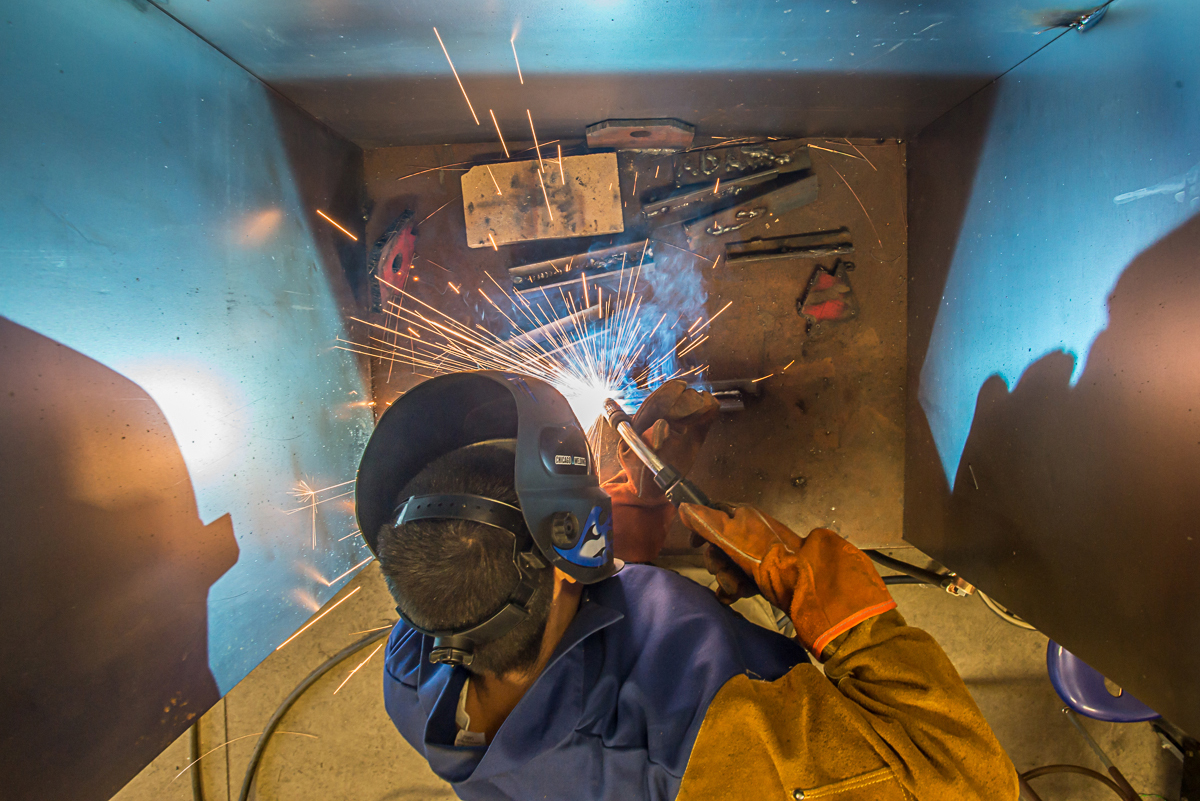CMC-Lake County High School partnership provides instruction, college credit – and a start on potential welding careers. By Carrie Click.

Isaac Dorsey wore a welding helmet embellished with an ominous skeleton skull as he used a plasma cutter on a metal box, sparks flying up toward the student’s shielded face.
In early December, Dorsey and half a dozen students from Lake County High School were at Colorado Mountain College in Leadville for their welding class with CMC instructor Mark Godonis.
During the academic year, these high school juniors and seniors leave school one day a week to go to the college’s woodworking and welding shop. There, they spend a few hours each session getting familiar with welding techniques and perfecting their skills.
“I didn’t know about any of this before I took this class,” said Dorsey. “I’ve learned a lot.”
College credit – plus career skills

At the beginning of the fall semester, Godonis, a professional welder and certified welding inspector, taught his students how to gas weld and cut, a process that originated in the early 20th century to permanently join steel. Godonis said it’s an old but important skill for his students to learn.
“They learn what the fusion process is,” said Godonis. “They don’t grasp the concept without that.”
After several months, he introduced them to metallic inert gas, or MIG, welding, a semi-automated gas shielded process used on all types of commercially available metals.
This fall was the first time that Colorado Mountain College offered this class to Lake County High School students, said Kelly Hofer, LCHS’s pre-collegiate coordinator. Through the state’s concurrent enrollment program, as with other dual-enrollment college classes like math or English composition, students who complete the course with a C or better get both high school and college credit, at no cost to them.
“We work closely with CMC to create as many opportunities for our students as possible,” Hofer said. “We are excited about the doors [this class] will open for them.”
For student Dorsey, the college’s welding class has piqued his interest, and not just for the moment. “I’d like to work for Xcel or on a pipeline,” he said.
Berlie Mascarenez, a junior, said he heard about CMC’s welding class from Hofer and Julie McMurry, another Lake County High School counselor. He said he is interested in joining the Navy, to use what he’s learning.
“I want to go into underwater welding,” he said.
Senior David Avila currently works for the road and bridge department while going to school. He said his high school counselors referred him to the class because they knew he would be interested in it.
“I use what I’ve learned here now at work,” he said.
Welding changes with the times
According to instructor Godonis, the welding industry is looking for workers not only knowledgeable about the process, but who also understand how to work with automated systems and robotics.
“The workforce is turning over,” he said. “Baby boomers are on their way out. When the industry automated about 20 years ago, productivity increased but labor was cut by 70 percent. That was bad for the guys who didn’t have the skills. Either you evolve or become a dinosaur.”
What’s changed, too, is how welders learn how to weld. Previously, industrial arts like welding was part of the curriculum in a typical high school shop class. That’s changed, as many high schools across the country are partnering with higher education institutions like Colorado Mountain College to provide technical skills to pre-collegiate students.
“It’s very common,” said Godonis, who has nearly 40 years of shipbuilding and manufacturing experience in the industry and who led a similar welding instruction program in Illinois before coming to Colorado. “Community colleges and vocational centers have centralized much of this instruction.”
For prospective welders, the job outlook is slightly on the rise, at a 6 percent increase from 2012 to 2022, according to the Bureau of Labor Statistics. Godonis said two of his CMC college students recently landed jobs – locally in the railroad industry, and on the Front Range, working in stainless steel processing.
“Those jobs are not going to go away,” he said.
